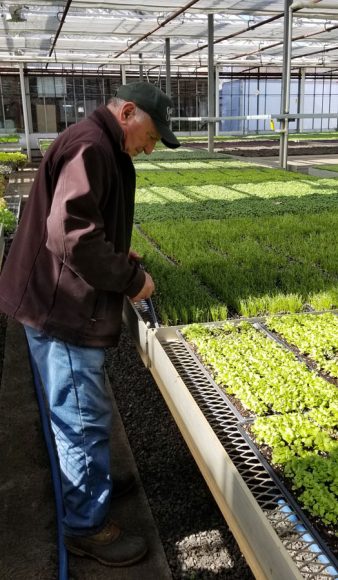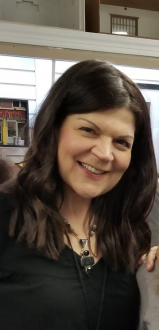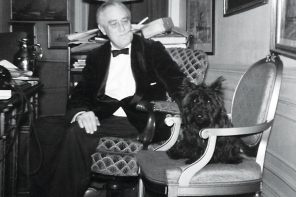Up in the rolling hills of Easton sits a modest farmhouse that fronts the formidable operations of Gilbertie’s Organic Petite Edibles and Herb Gardens under the able stewardship of Sal Gilbertie, a wholesale grower of considerable renown, particularly in this niche business.
The name may be more familiar to locals from their experiences at Gilbertie’s Herbs & Garden Center, a family-owned business that began operations on Sylvan Lane in Westport more than 90 years ago. This is a full-service garden center that sells many of the products grown in Easton, along with a fanciful assortment of garden center necessities and luxuries alike.
In addition to being a sizable retail operation, the center offers events and acts as the winter host of the Westport Farmers Market, much to the delight of the community. The garden center and its operations are run by Carrie Gilbertie, Sal’s daughter-in-law, who suggests the tour of the impressive operation, about 15 minutes outside of town.
Gilbertie’s Organic Petite Edibles and Herb Gardens have a long and storied history — and a passionate proprietor. “I’m a (third-generation) grower. I’ve always been a grower — that’s what I do,” he says. And it shows in the warmth of his weathered face and hands. Together with about 30 employees, he produces an abundant variety of herbs, microgreens and petite edibles and vegetables within their 27 greenhouses year-round, and spread across their outdoor acreage, the former property of the Keller Farm.
In these early days of April, the tables are bursting with color, as they produce 2,000 flats a week of about 38 different varieties of crops — the numbers roll easily off Sal’s tongue. They are currently harvesting the cold crops for distribution to their commercial clients — local boutique markets and chain grocers among them, together with restaurant suppliers.
Gilbertie lives and breathes on this property and tends to every aspect of the business. “I love what I do,” he says, “and I live here because things happen — pipes burst overnight and I have to tend to it.” Throughout the Northeast’s culinary community he’s a legend — but hearing his telling is an education.
As our first order of business, we sit in his “open office” in the midst of one of the greenhouses — well, I sit, and he tells me the fascinating history of this family business, one whose ebbs and flows followed the cycles in the cut flower and herb businesses of industrial America.
His grandfather, Antonio Gilbertie, came from Italy to the United States in 1901, together with his pregnant wife and three brothers. The name had been changed, as many were upon entry, from
Gilaberti. Antonio came specifically to work for the Fillow Flower Co. in Westport, which employed many Italian, Irish and English immigrants.
The company grew cut flowers of the typical garden variety — roses, tulips and the like — that were sent by rail to commercial customers across the Northeast. In 1919, Antonio bought the property on Sylvan Lane in Westport that is home to the family’s garden center and started building greenhouses, with A. Gilbertie Flowers established by 1922. He grew more ornamental, exotic varieties of flowers such as anemones and ranunculus. With his expertise in greenhouse growing, he was able to “pre-cool” bulbs like iris, daffodils and tulips and get them into the New York metro market two months ahead of everyone else.
The business flourished, Gilbertie says, particularly with “victory gardens” spurring the seedling movement during World War II. Postwar, the increasing ability to ship goods by air changed the dynamic of the cut-flower market, with the explosion of the Holland bulb in the 1950s. So growers had to diversify into seasonal potted plants like kalanchoës, geraniums, petunias and poinsettias.
The business was booming in the late ’50s, doing more contract work, providing plants for estates — one, in particular, being that of Baroness Gabriele von Langendorff in Westport. But in February of 1959, Gilbertie’s father died prematurely. He credits Edna Percy Cashmore of the Herb Society of America, with whom he had become acquainted through their board meetings, with turning his life around. “She taught me everything I know about herbs — sourcing and identification — and she introduced me to experts in the business,” who enabled his growth, he says.
Gilbertie’s became the only grower in the Northeast producing herbs in large volume. The ecology boom of the 1970s brought further good fortune and the purchase of the land where Gilbertie’s Organic Petite Edibles and Herb Gardens operate today.
Among Gilbertie’s petite edibles of the floral variety are the nasturtium plants whose leaves and yellow and orange flowers are not only beautiful, but nutritious.
As we walk through the greenhouses, he pinches off a small section of a low-hanging branch and hands it to me with the simple command, “eat it.” It’s soft and tender, but unexpectedly tasty and mildly peppery. I basically want to eat my way through the greenhouse like one of the rabbits he raises on the property, solely for fun, he says.
No surprise that these tender flowers and their leaves are tossed into salads, used to garnish artful plates and even wedding cakes.
Martha Stewart, a longtime fan who hosted Gilbertie on her show, offers recipes for everything from nasturtium pesto to risotto on her website. Its taste is otherworldly, as are its benefits. Nasturtium is high in vitamin C, along with manganese, iron, flavonoids and beta carotene, so it is widely found in herbal remedies for everything from hair loss to boosting the immune system.
It was humbling to have had this private lesson from Gilbertie, who doesn’t bring up his books — turns out he has written five on the topic of organic growing — or his brushes with culinary luminaries. Rather, he tells me to look at the turn of events that propelled his business and enabled his success.
His fastidiousness didn’t hurt either, or his concerted decision to be an organic grower, going fully organic in 2002 and adhering to the arduous protocols that this designation mandates, if followed properly. He cultivates his own soil — pointing to the soil barn during our tour — with natural fungicides like long-needle, yellow pine bark from North Carolina and specially created organic peat moss from Canada.
We have seen the benefits of eating organic, he says, and we have seen the abatement of allergies and many other conditions as a result of eliminating the toxicity of pesticides from our diets. The products are more expensive — Gilbertie cites his adherence to the practice of conducting additional, elective audits by certified specialists, undertaken at much expense — in order to maintain his high organic standards, a doctrine to which he firmly subscribes and one he will not relinquish.
It’s apparent that Gilbertie is happy in his world among his seedlings in Easton — telling me a mantra heard often and again from those who succeed: You have to be happy in what you do. Recalling the stories he shared of the people who came into his life and bolstered his business, especially after losing his father, he ponders, “Had these events not happened, would I have been so lucky?” Then he quickly restates his question, “No, not lucky, blessed.”
For more, visit petiteedibles.com.





